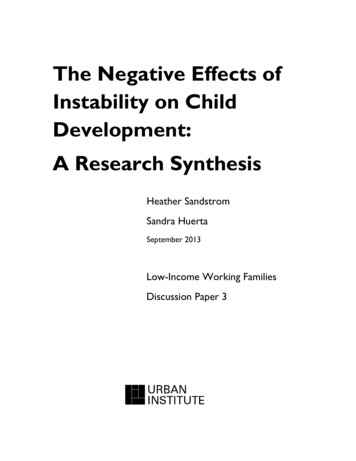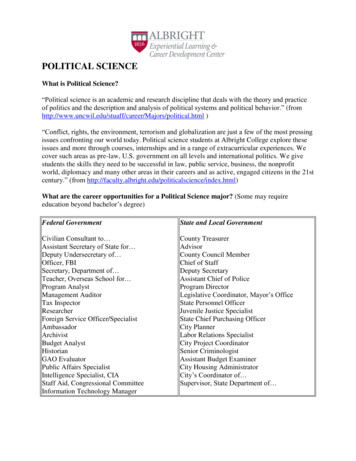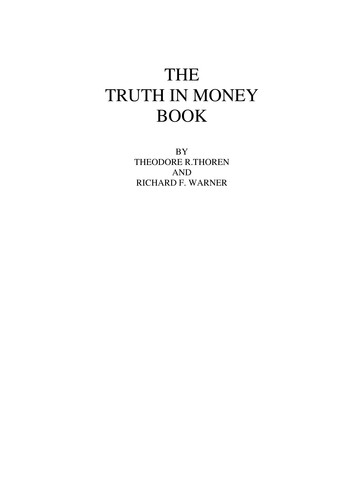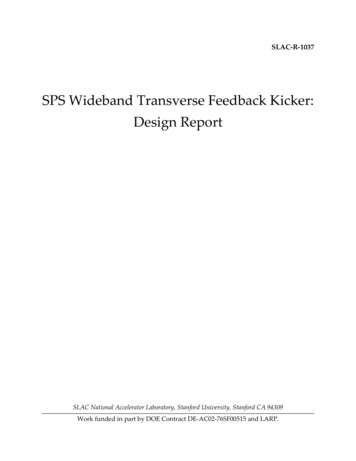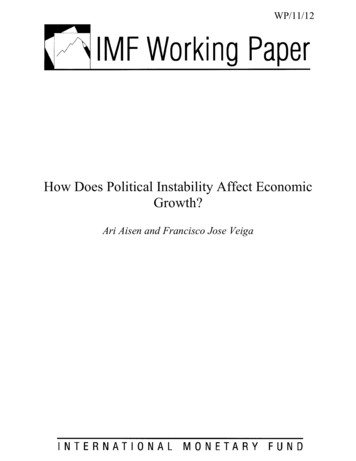
Transcription
WP/11/12How Does Political Instability Affect EconomicGrowth?Ari Aisen and Francisco Jose Veiga
2010 International Monetary FundWP/11/12IMF Working PaperMiddle East and Central Asia DepartmentHow Does Political Instability Affect Economic Growth?Prepared by Ari Aisen and Francisco Jose VeigaAuthorized for distribution by Ana Lucía CoronelJanuary 2011AbstractThis Working Paper should not be reported as representing the views of the IMF.The views expressed in this Working Paper are those of the author(s) and do not necessarilyrepresent those of the IMF or IMF policy. Working Papers describe research in progress by theauthor(s) and are published to elicit comments and to further debate.The purpose of this paper is to empirically determine the effects of political instability oneconomic growth. Using the system-GMM estimator for linear dynamic panel data modelson a sample covering up to 169 countries, and 5-year periods from 1960 to 2004, we findthat higher degrees of political instability are associated with lower growth rates of GDPper capita. Regarding the channels of transmission, we find that political instabilityadversely affects growth by lowering the rates of productivity growth and, to a smallerdegree, physical and human capital accumulation. Finally, economic freedom and ethnichomogeneity are beneficial to growth, while democracy may have a small negative effect.JEL Classification Numbers: 043, 047Keywords: Economic growth, political instability, growth accounting, productivity.Author’s E-Mail Address: aaisen@imf.org; -----------------*Ari Aisen: International Monetary Fund (aaisen@imf.org). Francisco Jose Veiga: Universidade do Minhoand NIPE Escola de Economía e Gestão, 4710-057 Braga, Portugal (fjveiga@eeg.uminho.pt)**The authors wish to thank John H. McDermott, conference participants at the 2010 Meeting of theEuropean Public Choice Society and at the Fourth Conference of the Portuguese Economic Journal andseminar participants at the University of Minho for useful comments. Finally, we thank Luísa Benta forexcellent research assistance.
2ContentsPageI. Introduction .3II. Data and the Empirical Model .4III. Empirical Results .8IV. Conclusions.24References .27
3I. INTRODUCTIONPolitical instability is regarded by economists as a serious malaise harmful to economicperformance. Political instability is likely to shorten policymakers’ horizons leading to suboptimal short term macroeconomic policies. It may also lead to a more frequent switch ofpolicies, creating volatility and thus, negatively affecting macroeconomic performance.Considering its damaging repercussions on economic performance the extent at which politicalinstability is pervasive across countries and time is quite surprising. Political instability asmeasured by Cabinet Changes, that is, the number of times in a year in which a new premier isnamed and/or 50 percent or more of the cabinet posts are occupied by new ministers, is indeedglobally widespread displaying remarkable regional differences (see Figure 1).The widespread phenomenon of political (and policy) instability in several countriesacross time and its negative effects on their economic performance has arisen the interest ofseveral economists. As such, the profession produced an ample literature documenting thenegative effects of political instability on a wide range of macroeconomic variables including,among others, GDP growth, private investment, and inflation. Alesina et al. (1996) use data on113 countries from 1950 to 1982 to show that GDP growth is significantly lower in countriesand time periods with a high propensity of government collapse. In a more recent paper, Jong-aPin (2009) also finds that higher degrees of political instability lead to lower economic growth.1As regards to private investment, Alesina and Perotti (1996) show that socio-political instabilitygenerates an uncertain politico-economic environment, raising risks and reducing investment.2Political instability also leads to higher inflation as shown in Aisen and Veiga (2006). Quiteinterestingly, the mechanisms at work to explain inflation in their paper resemble those affectingeconomic growth; namely that political instability shortens the horizons of governments,disrupting long term economic policies conducive to a better economic performance.This paper revisits the relationship between political instability and GDP growth. This isbecause we believe that, so far, the profession was unable to tackle some fundamental questionsbehind the negative relationship between political instability and GDP growth. What are themain transmission channels from political instability to economic growth? How quantitativelyimportant are the effects of political instability on the main drivers of growth, namely, totalfactor productivity and physical and human capital accumulation? This paper addresses these1A dissenting view is presented by Campos and Nugent (2002), who find no evidence of a causal and negativelong-run relation between political instability and economic growth. They only find evidence of a short-run effect.2Perotti (1996) also finds that socio-political instability adversely affects growth and investment. For a theoreticalmodel linking political instability and investment, see Rodrik (1991).
4important questions providing estimates from panel data regressions using system-GMM3 on adataset of up to 169 countries for the period 1960 to 2004. Our results are strikingly conclusive:in line with results previously documented, political instability reduces GDP growth ratessignificantly. An additional cabinet change (a new premier is named and/or 50 percent ofcabinet posts are occupied by new ministers) reduces the annual real GDP per capita growth rateby 2.39 percentage points. This reduction is mainly due to the negative effects of politicalinstability on total factor productivity growth, which account for more than half of the effects onGDP growth. Political instability also affects growth through physical and human capitalaccumulation, with the former having a slightly larger effect than the latter. These results go along way to clearly understand why political instability is harmful to economic growth. Itsuggests that countries need to address political instability, dealing with its root causes andattempting to mitigate its effects on the quality and sustainability of economic policiesengendering economic growth.The paper continues as follows: section II describes the dataset and presents theempirical methodology, section III discusses the empirical results, and section IV concludes thepaper.II. DATA AND THE EMPIRICAL MODELAnnual data on economic, political and institutional variables, from 1960 to 2004 weregathered for 209 countries, but missing values for several variables reduce the number ofcountries in the estimations to at most 169. The sources of economic data were the Penn WorldTable Version 6.2 – PWT (Heston et al., 2006), the World Bank’s World DevelopmentIndicators (WDI) and Global Development Network Growth Database (GDN), and theInternational Monetary Fund’s International Financial Statistics (IFS). Political andinstitutional data were obtained from the Cross National Time Series Data Archive – CNTS(Databanks International, 2007), the Polity IV Database (Marshall and Jaggers, 2005), the StateFailure Task Force database (SFTF), and Gwartney and Lawson (2007).The hypothesis that political instability and other political and institutional variablesaffect economic growth is tested by estimating dynamic panel data models for GDP per capitagrowth (taken from the PWT) for consecutive, nonoverlapping, five-year periods, from 1960 to2004.4 Our baseline model includes the following explanatory variables (all except Initial GDPper capita are averaged over each five-year period):3System-GMM is a useful methodology to estimate the effects of political instability on growth since it proposes aclear-cut solution to the endogeneity problem involving these two variables. Using natural instruments forcontemporaneous political instability, this econometric method allows for the calculation of the causal effect ofpolitical instability on growth independent of the feedback effect of growth on political instability.4The periods are: 1960–64, 1965–69, 1970–74, 1975–79, 1980–84, 1985–89, 1990–94, 1995–99, and 2000–04.
5 Initial GDP per capita (log) (PWT): log of real GDP per capita lagged by one five-yearperiod. A negative coefficient is expected, indicating the existence of conditionalconvergence among countries. Investment (percent of GDP) (PWT). A positive coefficient is expected, as greaterinvestment shares have been shown to be positively related with economic growth (Mankiwet al., 1992). Primary school enrollment (WDI). Greater enrollment ratios lead to greater human capital,which should be positively related to economic growth. A positive coefficient is expected. Population growth (PWT). All else remaining the same, greater population growth leads tolower GDP per capita growth. Thus, a negative coefficient is expected. Trade openness (PWT). Assuming that openness to international trade is beneficial toeconomic growth, a positive coefficient is expected. Cabinet changes (CNTS). Number of times in a year in which a new premier is namedand/or 50 percent of the cabinet posts are occupied by new ministers. This variable is ourmain proxy of political instability. It is essentially an indicator of regime instability, whichhas been found to be associated with lower economic growth (Jong-a-Pin, 2009). A negativecoefficient is expected, as greater political (regime) instability leads to greater uncertaintyconcerning future economic policies and, consequently, to lower economic growth.In order to account for the effects of macroeconomic stability on economic growth, twoadditional variables will be added to the model:5 Inflation rate (IFS).6 A negative coefficient is expected, as high inflation has been found tonegatively affect growth. See, among others, Edison et al. (2002) and Elder (2004).Government (percent of GDP) (PWT). An excessively large government is expected tocrowd out resources from the private sector and be harmful to economic growth. Thus, anegative coefficient is expected.The extended model will also include the following institutional variables:7 Index of Economic Freedom (Gwartney and Lawson, 2007). Higher indexes are associatedwith smaller governments (Area 1), stronger legal structure and security of property rights(Area 2), access to sound money (Area 3), greater freedom to exchange with foreigners5Here, we follow Levine et al. (2000), who accounted for macroeconomic stability in a growth regression byincluding the inflation rate and the size of government.6In order to avoid heteroskedasticity problems resulting from the high variability of inflation rates, Inflation wasdefined as log(1 Inf/100).7There is an extensive literature on the effects of institutions on economic growth. See, among others, Acemoglu etal. (2001), Acemoglu et al. (2003), de Hann (2007), Glaeser et al. (2004), and Mauro (1995).
6 (Area 4), and more flexible regulations of credit, labor, and business (Area 5). Since all ofthese are favorable to economic growth, a positive coefficient is expected.Ethnic Homogeneity Index (SFTF): ranges from 0 to 1, with higher values indicating ethnichomogeneity, and equals the sum of the squared population fractions of the seven largestethnic groups in a country. For each period, it takes the value of the index in the beginningof the respective decade. According to Easterly, et al. (2006), “social cohesion” determinesthe quality of institutions, which has important impacts on whether pro-growth policies areimplemented or not. Since higher ethnic homogeneity implies greater social cohesion,which should result in good institutions and pro-growth policies, a positive coefficient isexpected.8Polity Scale (Polity IV): from strongly autocratic (-10) to strongly democratic (10). Thisvariable is our proxy for democracy. According to Barro (1996) and Tavares and Wacziarg(2001), a negative coefficient is expected.9Descriptive statistics of the variables included in the tables of results are shown in Table 1.Table 1. Descriptive StatisticsVariableObs.MeanSt. Dev.Min.Growth of GDP per capitaGDP per capita (log)Growth of Physical CapitalPhysical Capital per capita (log)Growth of TFPTFP (log)Growth of Human CapitalHuman Capital per capita (log)Investment (percent of GDP)Primary School EnrollmentPopulation GrowthTrade (percent of GDP)Government (percent of GDP)Inflation [ ln(1 Inf/100)]Cabinet ChangesRegime Instability Index 1Regime Instability Index .347PWT11.346PWT0.463PWT11.718PWT0.292 PWT, BL12.074 PWT, BL0.080BL0.597BL91.964PWT149.240 CNTS8.018 CNTS-PCA7.806 CNTS-PCA8See Benhabib and Rusticini (1996) for a theoretical model relating social conflict and growth.9On the relationship between democracy and growth, see also Acemoglu, et al. (2008).
7Regime Instability Index 3Violence IndexPolitical Instability IndexIndex of Economic FreedomArea 2:Legal Structure andSecurity of Property RightsPolity ScaleEthnic Homogeneity 7860.8871.208-0.813-0.435-0.7772.0046.040 CNTS-PCA4.712 CNTS-PCA6.557 0.2390.5837.3910.277-10.0000.15010.0001.000Polity IVSFTFSources:BL: Updated version of Barro and Lee (2001).CNTS: Cross-National Time Series database (Databanks International, 2007).CNTS-PCA: Data generated by Principal Components Analysis using variables from CNTS.EFW: Economic Freedom of the World (Gwartney and Lawson, 2007).IFS-IMF: International Financial Statistics - International Monetary Fund.Polity IV: Polity IV database (Marshall and Jaggers, 2005).PWT: Penn World Table Version 6.2 (Heston et al., 2006).SFTF: State Failure Task Force database.WDI-WB: World Development Indicators–World Bank.Notes: Sample of consecutive, non-overlapping, five-year periods from 1960 to 2004, comprising the169 countries considered in the baseline regression, whose results are shown in column 1 of Table 2.The empirical model for economic growth can be summarized as follows:ln Yit ln Yi ,t 1 ln Yi ,t 1 β' X it δPI i ,t λ ' Wit i t iti 1,., Nt 1,., Ti(1)where Yit stands for the GDP per capita of country i at the end of period t, Xit for a vector ofeconomic determinants of economic growth, PIit for a proxy of political instability, and Wit for avector of political and institutional determinants of economic growth; α, β, δ, and λ are theparameters and vectors of parameters to be estimated, i are country-specific effects, t areperiod specific effects, and, it is the error term. With 1 , equation (1) becomes:ln Yit ln Yi,t 1 β' X it δPI i,t λ ' Wit i t iti 1,., Nt 1,., Ti(2)One problem of estimating this dynamic model using OLS is that Yi,t-1 (the laggeddependent variable) is endogenous to the fixed effects (νi), which gives rise to “dynamic panelbias”. Thus, OLS estimates of this baseline model will be inconsistent, even in the fixed orrandom effects settings, because Yi,t-1 would be correlated with the error term, it, even if the
8latter is not serially correlated.10 If the number of time periods available (T) were large, the biaswould become very small and the problem would disappear. But, since our sample has only ninenon-overlapping five-year periods, the bias may still be important.11 First-differencing Equation(2) removes the individual effects ( i) and thus eliminates a potential source of bias: .Yit Yi ,t 1 β' X it δ PI i,t λ ' Wit t iti 1,., Nt 1,., Ti(3)But, when variables that are not strictly exogenous are first-differenced, they becomeendogenous, since the first difference will be correlated with the error term. FollowingHoltz-Eakin, Newey and Rosen (1988), Arellano and Bond (1991) developed a GeneralizedMethod of Moments (GMM) estimator for linear dynamic panel data models that solves thisproblem by instrumenting the differenced predetermined and endogenous variables with theiravailable lags in levels: levels of the dependent and endogenous variables, lagged two or moreperiods; levels of the predetermined variables, lagged one or more periods. The exogenousvariables can be used as their own instruments.A problem of this difference-GMM estimator is that lagged levels are weak instrumentsfor first-differences if the series are very persistent (see Blundell and Bond, 1998). According toArellano and Bover (1995), efficiency can be increased by adding the original equation in levelsto the system, that is, by using the system-GMM estimator. If the first-differences of anexplanatory variable are not correlated with the individual effects, lagged values of thefirst-differences can be used as instruments in the equation in levels. Lagged differences of thedependent variable may also be valid instruments for the levels equations.The estimation of growth models using the difference-GMM estimator for linear paneldata was introduced by Caselli et al. (1996). Then, Levine et al. (2000) used the system-GMMestimator12, which is now common practice in the literature (see Durlauf, et al., 2005, and Beck,2008). Although several period lengths have been used, most studies work with nonoverlappingfive-year periods.III. EMPIRICAL RESULTSThe empirical analysis is divided into two parts. First, we test the hypothesis thatpolitical instability has negative effects on economic growth, by estimating regressions for GDPper capita growth. As described above, the effects of institutional variables will also be10See Arellano and Bond (1991) and Baltagi (2008).According to the simulations performed by Judson and Owen (1999), there is still a bias of 20 percent in thecoefficient of interest for T 30.1112For a detailed discussion on the conditions under which GMM is suitable for estimating growth regressions, seeBond et al. (2001).
9analyzed. Then, the second part of the empirical analysis studies the channels of transmission.Concretely, we test the hypothesis that political instability adversely affects output growth byreducing the rates of productivity growth and of physical and human capital accumulation.3.1. Political Instability and Economic GrowthThe results of system-GMM estimations on real GDP per capita growth using a samplecomprising 169 countries, and nine consecutive and non-overlapping five-year periods from1960 to 2004 are shown in Table 2. Since low economic growth may increase governmentinstability (Alesina et al., 1996), our proxy for political instability, Cabinet changes, will betreated as endogenous. In fact, most of the other explanatory variables can also be affected byeconomic growth. Thus, it is more appropriate to treat all right-hand side variables asendogenous.13The results of the estimation of the baseline model are presented in column 1. Thehypothesis that political instability negatively affects economic growth receives clear empiricalsupport. Cabinet Changes is highly statistically significant and has the expected negative sign.The estimated coefficient implies that when there is an additional cabinet change per year, theannual growth rate decreases by 2.39 percentage points. Most of the results regarding the otherexplanatory variables also conform to our expectations. Initial GDP per capita has a negativecoefficient, which is consistent with conditional income convergence across countries.Investment and enrollment ratios14 have positive and statistically significant coefficients,indicating that greater investment and education promote growth. Finally, population growth hasthe expected negative coefficient, and Trade (percent of GDP) has the expected sign, but is notstatistically significant.Table 2. Political Instability and Economic GrowthInitial GDP per capita (log)Investment (percent of GDP)Primary School EnrollmentPopulation GrowthTrade (percent of ** -0.0177*** -0.0181*** *0.0007** 0.0012*** 0.00010.0001(1.743)(1.616)(1.134)(0.756)-0.273*** -0.232*** -0.271*** .63e-05-0.0000313Their twice lagged values were used as instruments in the first-differenced equations and their once-lagged firstdifferences were used in the levels equation.14The results are virtually the same when secondary enrollment is used instead of primary enrollment. Since wehave more observations for the latter, we opted to include it in the estimations reported in this paper.
ent (percent of GDP)Cabinet ChangesIndex of Economic FreedomArea2: Legal structure andsecurity of property rightsNumber of ObservationsNumber of CountriesHansen test (p-value)AR1 test (p-value)AR2 test 2.282)9.72e-06-0.0004(0.0302)(-1.366)-0.0200** -0.0244*** -0.0158**(-2.523)(-2.645)(-2.185)0.0109*** 7450.491Sources: See Table 1.Notes: - System-GMM estimations for dynamic panel-data models. Sample period: 1960–2004.- All explanatory variables were treated as endogenous. Their lagged values two periods wereused as instruments in the first-difference equations and their once lagged first-differenceswere used in the levels equation.- Two-step results using robust standard errors corrected for finite samples (using Windmeijer’s,2005, correction).- T-statistics are in parenthesis. Significance level at which the null hypothesis is rejected: ***,1 percent; **, 5 percent, and *, 10 percent.The results of an extended model which includes proxies for macroeconomic stabilityare reported in column 2 of Table 2. Most of the results are similar to those of column 1. Themain difference is that Trade (percent of GDP) is now statistically significant, which isconsistent with a positive effect of trade openness on growth. Regarding macroeconomicstability, inflation and government size have the expected signs, but only the first is statisticallysignificant.The Index of Economic Freedom15 is included in the model of column 3 in order toaccount for favorable economic institutions. It is statistically significant and has a positive sign,as expected. A one-point increase in that index increases annual economic growth by onepercentage point. Trade (percent of GDP) and Inflation are no longer statistically significant.This is not surprising because the Index of Economic Freedom is composed of five areas, someof which are related to explanatory variables included in the model: size of government (Area1), access to sound money (Area 3), and greater freedom to exchange with foreigners (Area 4).In order to avoid potential collinearity problems, the variables Trade (percent of GDP),15Since data for the Index of Economic Freedom is available only from 1970 onwards, the sample is restricted to1970 to 2004 when this variable is included in the model.
11Inflation, and Government (percent of GDP) are not included in the estimation of column 4. Theresults regarding the Index of Economic Freedom and Cabinet Changes remain essentially thesame.An efficient legal structure and secure property rights have been emphasized in theliterature as crucial factors for encouraging investment and growth (Glaeser, et al., 2004; Halland Jones, 1999; La-Porta, et al., 1997). The results shown in column 5, where the Index ofEconomic Freedom is replaced by its Area 2, Legal structure and security of property rights, areconsistent with the findings of previous studies.16In the estimations whose results are reported in Table 3, we also account for the effects ofdemocracy and social cohesion, by including the Polity Scale and the Ethnic Homogeneity Indexin the model. There is weak evidence that democracy has small adverse effects on growth, as thePolity Scale has a negative coefficient, small in absolute value, which is statistically significantonly in the estimations of columns 1 and 3. These results are consistent with those of Barro(1996) and Tavares and Wacziarg (2001)17. As expected, higher ethnic homogeneity (socialcohesion) is favorable to economic growth, although the index is not statistically significant incolumn 4. The results regarding the effects of political instability, economic freedom, andsecurity of property rights are similar to those found in the estimations of Table 2. The mostimportant conclusion that we can withdraw from these results is that the evidence regarding thenegative effects of political instability on growth are robust to the inclusion of institutionalvariables.Considering that political instability is a multi-dimensional phenomenon, eventually notwell captured by just one variable (Cabinet Changes), we constructed five alternative indexes ofpolitical instability by applying principal components analysis.1816Since Investment (percent of GDP) is included as an explanatory variable, the Area 2 will also affect GDPgrowth through it. Thus, the coefficient reported for Area 2 should be interpreted as the direct effect on growth,when controlling for the indirect effect through investment. This direct effect could operate through channels suchas total factor productivity and human capital accumulation.17Tavares and Wacziarg (2001) justify the negative effect of democracy on growth as the net contribution ofdemocracy to lowering income inequality and expanding access of education to the poor (positive) at the expenseof physical capital accumulation (negative).18This technique for data reduction describes linear combinations of the variables that contain most of theinformation. It analyses the correlation matrix, and the variables are standardized to have mean zero and standarddeviation of 1 at the outset. Then, for each of the five groups of variables, the first component identified, the linearcombination with greater explanatory power, was used as the political instability index.
12Table 3. Political Instability, Institutions, and Economic GrowthInitial GDP per capita (log)Investment (percent of GDP)Primary School EnrollmentPopulation GrowthTrade (percent of overnment (percent of GDP)Cabinet ChangesIndex of Economic FreedomArea2: Legal structure and security ofproperty rightsPolity ScaleEthnic Homogeneity IndexNumber of ObservationsNumber of CountriesHansen test (p-value)AR1 test (p-value)AR2 test 4941090.9924.38e-050.456Sources: See Table 1.Notes: - System-GMM estimations for dynamic panel-data models. Sample period: 1960–2004.- All explanatory variables were treated as endogenous. Their lagged values two periods wereused as instruments in the first-difference equations and their once lagged first-differenceswere used in the levels equation.- Two-step results using robust standard errors corrected for finite samples (usingWindmeijer’s, 2005, correction).- T-statistics are in parenthesis. Significance level at which the null hypothesis is rejected: ***,1 percent; **, 5 percent, and *, 10 percent.The first three indexes include variables that are associated with regime instability, the fourthhas violence indicators, and the fifth combines regime instability and violence indicators. Thevariables (all from the CNTS) used to define each index were:o Regime Instability Index 1: Cabinet Changes and Executive Changes.
13ooooRegime Instability Index 2: Cabinet Changes, Constitutional Changes, Coups,Executive Changes, and Government Crises.Regime Instability Index 3: Cabinet Changes, Constitutional Changes, Coups,Executive Changes, Government Crises, Number of Legislative Elections, andFragmentation Index.Violence Index: Assassinations, Coups, and Revolutions.Political Instability Index: Assassinations, Cabinet Changes, Constitutional Changes,Coups, and Revolutions.The results of the estimati
Number of times in a year in which a new premier is named and/or 50 percent of the cabinet posts are occupied by new ministers. This variable is our main proxy of political instability. It is essentially an indicator of regime instability, which has been found to be associated with lower economic growth (Jong-a-Pin, 2009). A negative
